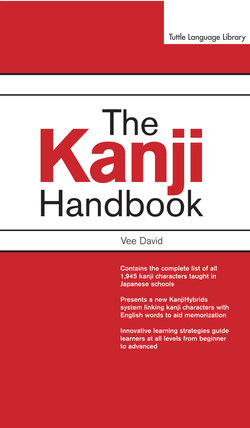Читать книгу Kanji Handbook - Vee David - Страница 14
На сайте Литреса книга снята с продажи.
ОглавлениеFlip-It Index: How to Search
SUMMARY: The new indexing system has two main components in which to categorize Kanji characters: Flippable and Non-flippable. Flippable means the whole Kanji character, or sub-elements within, when inverted horizontally will remain almost the same—disregarding hooks, backlashes and "ink stops." Examples include: 本, 中 and 田. Most Kanji characters fit in the "Flippable" category, so many sub-categories were used to organize and make searching for them more time efficient. For example, some Kanji characters are only flippable on the top, the right side, the bottom, the top left side, etc. Nearly all sub-categories in the "Flippable" section are separated as having either a flat base or a stem base. A flat base means the baseline is all flat and touching the ground. Flat base flippable Kanji characters will look like the following: 山, 田 or 西. Kanji characters with a stem base will look like it has legs sticking out or poles mounted on the ground: 本, 川 or 卵. Non-flippable Kanji characters are those facing either the left or right side, or a combination of both. Examples include: 子, 己 and 生 facing the left side (West), and 上, 女 and 糸 facing the right side (East). Look for what appears to be a long, flat back with the front side protruding, or with an opening. Unlike other Kanji indexing systems, no pre-existing knowledge is required. Just look closely, flip it, then find its match in the correlating section. The Flip-In Index begins on page 1112.
EXERCISE: How does an absolute novice locate a Kanji character in the index? The examples below will illustrate the possibilities.
Example 1: Search for 舗
a) One can clearly see that the Kanji character 舗 is not wholly flippable; it would look very different when inverted horizontally.
b) However, one can conclude that its left side 舎 is flippable; it would look roughly the same when turned around.
c) In addition, the bottom part 口 of 舎 has a flat base —as distinguished from a stem base.
d) Hence, the Kanji character 舗 can be located in sub-section: 6.0.a. Left Whole (Flat Base) on page 1117.
Example 2: Search for 蚕
a) One can clearly see that the Kanji character 蚕 is not wholly flippable; it would look very different when inverted horizontally.
b) However, one can conclude that its top part 天 is flippable; it would look roughly the same when turned around.
c) Also, the bottom part of 天 has a stem base—two poles touching the ground.
d) Hence, the Kanji character 蚕 can be located in sub-section: 3.0.b. Top (Stem) on page 1115.
Example 3: Search for 態
a) One can clearly see that the Kanji character 態 is neither wholly nor partially flippable; none of its sub-elements would look the same when inverted from left to right, or vice versa.
b) The Kanji character 態 can be divided into two sub-elements, namely 能 and 心 on a horizontal split.
c) Looking for what appears to be the dominant protruding part, or an opening and a long-flat back, one clearly see that the sub-elements 能 and 心 are both facing to the right side or East.
d) Hence, the Kanji character 態 can be located in sub-section: 2.1. Facing East (Horizontal Split) on page 1123.
Example 4: Search for 張
a) One can clearly see that the Kanji character 張 is neither wholly nor partially flippable; none of its sub-elements would look the same when inverted from left to right or vice versa.
b) The Kanji character 張 can be divided into two sub-elements, namely 弓 and 長 on a vertical split.
c) Looking for what appears to be the dominant protruding side, or an opening and a long-flat back, one clearly see that the sub-element 弓 and 長 are both facing apart, or opposite each other.
d) Hence, the Kanji character 張 can be located in sub-section: 4.0. Facing Apart on page 1126.
The Flip-It Index: Origin
Over the years, the urge to devise a Kanji indexing system, accessible by absolute beginners, refused to subside. One extremely cold winter night, I was in a hot spring in Miyazaki, Japan contemplating semi-thoughts. Then, I noticed the glass wall in front of me had the letters "HOH" painted on it. I have seen and ignored these letters many times. I walked past the glass wall to the outer garden, and then took a hard look at the same inverted letters. I then realized something self-evident: Writing systems were meant to be symmetrical, which when inverted horizontally would look almost the same. That concept would later spring forth to life the Flip-It Index (see p. 1112), where Kanji characters are categorized according to their "flippability." Partially-flippable Kanji—meaning the bottom, top, left, or right side only, can be flipped—are grouped together. Non-flippable Kanji characters face either the West or East, based on what appears to be a long, flat back and something protruding. Thus, the Flip-It Index is categorized by whether a Kanji character is flippable, partially-flippable, or non-flippable. The end result is a new Kanji indexing system, where learners can navigate without any preexisting knowledge. All one has to do is look carefully:
Flippable: 豊bundance, 奉dore, 同like, 堂ltar, 宣nnounce; or partially-flippable such as: 農arming (top), 盟lliance (bottom), 彰ward (left), and 細lender (right).
Non-Flippable: 子hildren (Facing West), 止top (Facing East), 約romise (Facing Across), and 私rivate (Facing Apart)
